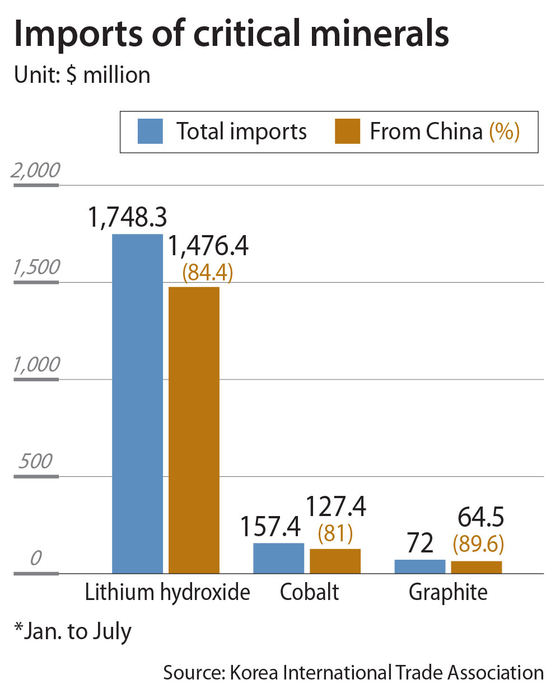[ANALYSIS] After U.S. law, battery makers have big sourcing problems
![LG Energy Solution researchers check batteries for electric vehicles at its Ochang plant in North Chungcheong. [LG ENERGY SOLUTION]](https://koreajoongangdaily.joins.com/data/photo/2022/09/04/cf319b4f-354a-4624-b572-7d2ab2b41603.jpg)
LG Energy Solution researchers check batteries for electric vehicles at its Ochang plant in North Chungcheong. [LG ENERGY SOLUTION]
Taking China out of the equation is the priority, and some companies are finding ways to extract minerals from used batteries.
Under the terms of the Inflation Reduction Act (IRA), buyers of EVs assembled in the United States are eligible for a $7,500 tax credit for vehicles purchased after Aug. 16, 2021, extending an existing program that offered a $7,500 tax credit for EV purchases regardless of origin.
After Jan. 1, 2023, content requirements for batteries begin to phase in over a number of years. In 2023, 40 percent of critical-mineral value will have to come from the United States or countries that the United States has signed free trade agreements with to qualify for $3,750 of the credit. That number increases 10 percentage points a year to 80 percent in 2027.
Fifty percent of battery-component value will have to come from the United States to qualify for another $3,750 of the tax credit. That number will increase 10 percentage points a year to 100 percent by 2029.
To qualify for the subsidy, a vehicle must be completely free of Chinese-made components from 2024 and free of Chinese critical minerals from 2025.
Critical minerals include lithium, cobalt, nickel, tin, tungsten and graphite, while components include cathodes, anodes, electrolytes and separators made with those minerals.
Eighty-four percent of lithium hydroxide imported into Korea came from China in the first seven months of this year, according to data from the Korea International Trade Association. Some 81 percent of cobalt came from China, as did 90 percent of graphite.
China is home to four of the world’s five biggest lithium processing companies including Ganfeng Lithium in Jiangxi. In terms of graphite, 80 percent of the world's supply is mined in China, and six of its largest graphite producers are headquartered in China.

The International Energy Agency wrote in a recent report that China controls 70 percent of the world’s cathode production and 85 percent of anode production.
"Korea should always keep in mind that our EV industry could be controlled by China if we continue to rely on China this heavily,” said Lee Hang-gu, a senior analyst at Korea Automotive Technology Institute. “Local companies must tighten their cooperation with major mining countries that have free trade agreements with Korea, such as Australia, Canada, Chile and Indonesia.”
LG Energy Solution, Korea’s largest and the world’s second-largest battery maker, signed supply deals with a total of 10 materials companies from seven countries for the supply of critical minerals.
It invested 12 billion won ($8.9 million) for a 7.5 percent stake in Queensland Pacific Metals (QPM). The Australia-based battery materials company will supply 7,000 tons of nickel and 700 tons of cobalt annually for 10 years from the end of 2023.
It also signed a deal with Kansas-based Compass Minerals and will source 40 percent of its lithium carbonate and lithium hydroxide from it for seven years starting in 2025.
QPM will also supply Samsung SDI with 6,000 tons of nickel every year for up to five years. QPM produces about 24,000 tons of nickel every year, 80 percent of which will be supplied to LG Energy Solution and Samsung SDI.
Samsung SDI has teamed up with EcoPro BM for supplies of cathodes. EcoPro BM will get precursors from EcoPro Materials, its subsidiary, process them and sell them to SDI and SK On. Precursors are raw materials used to make cathodes and are produced by combining materials such as nickel, cobalt and manganese. They account for over 60 percent of the cost of cathodes.
SK Innovation in 2019 signed a six-year deal to buy 30,000 tons of cobalt from Switzerland's Glencore starting from 2020, for its battery subsidiary SK On.
Posco Chemical earlier in the month succeeded in developing synthetic graphite, one of the key minerals in making anodes, which it will sell to Korea’s three battery manufacturers. Batteries with synthetic graphite are known to last longer and charge faster.
Posco Chemical’s production capacity for graphite currently stands at 8,000 tons per year. It aims to increase that to 16,000 tons.
But analysts say new sourcing of the materials is only one solution. As it gets tougher and tougher to secure minerals, companies are setting their sights on the recycling of used batteries and the extraction of key materials.
LG Energy Solution invested 60 billion won in a 2.6 percent stake in Canada's Li-Cycle to access 20,000 tons of nickel for a decade starting in 2023. That is enough for 300,000 EVs. Li-Cycle is the largest battery recycling company in North America.
It also signed an agreement with Zhejiang Huayou Cobalt to establish a joint venture that recycles battery materials. Huayou Cobalt is China’s biggest cobalt producer.
SK Innovation has been researching ways to extract lithium hydroxide from used batteries since 2019, with the goal of commercializing the process in 2025. The extracted lithium hydroxide can be used to make high-nickel lithium-ion batteries, the company said.
“Countries that are highly dependent on imports are exposed to the high risk of disruptions to supply chains, and the biggest way to hedge that is the recycling of used batteries,” said Ha In-hwan, a KB Securities analyst.
BY SARAH CHEA [chea.sarah@joongang.co.kr]










with the Korea JoongAng Daily
To write comments, please log in to one of the accounts.
Standards Board Policy (0/250자)